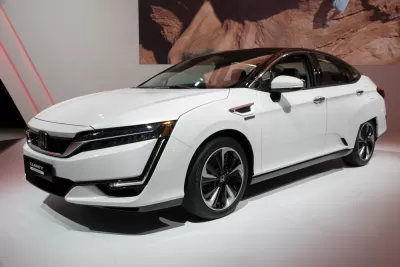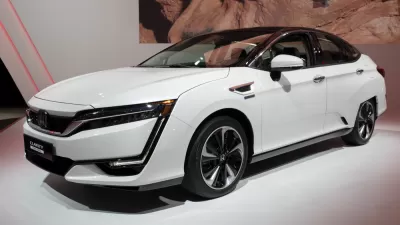The only state where fuel cell electric vehicles can be leased is California where 30 hydrogen refueling stations exist now, with 100 planned to be in operation by 2020. Almost no public refueling stations exist elsewhere, but that's about to change.

"Automakers and environmentalists have long hailed fuel cells as a revolutionary technology that can reduce planet-warming tailpipe emissions, which account for a significant portion of the greenhouse gases released in the United States," writes Neal Boudette, automotive reporter for The New York Times.
After years of development, several models are now on the road, like the Toyota Mirai and the Honda Clarity FC [and soon the Hyundai Tucson].
2017 Honda Clarity |
2017 Hyundai Tucson Fuel Cell | 2017 Toyota Mirai |
 |
 |
 |
| Credit: U.S. Department of Energy |
Expansion
The Northeast is “the next critical step toward a much wider distribution of fuel-cell vehicles,” said Craig Scott, director of Toyota’s advanced technology group. The densely populated Northeastern states “in some sense could rival California as a market,” he said, adding, “As a region, they have very good sales potential.”
Locations are in New York, New Jersey, Massachusetts, and Connecticut. All have adopted the more rigorous California vehicle emission standards.
Air Liquide, a producer of industrial gases, is working with Toyota to set up a chain of 12 hydrogen fueling stations stretching from New York to Boston; the first is expected to go into operation later this year. Locations will include the Bronx; Brooklyn; Hempstead, N.Y., on Long Island; Lodi, N.J.; Hartford; and Braintree and Mansfield, Mass.
One challenge facing fuel cell electric vehicle manufacturers is having to deal with several states, unlike the Golden State with its Air Resources Board committed to a goal of placing 4 million zero-emission vehicles in California by 2030. Unlike a battery electric vehicle, a fuel cell electric vehicle (FCEV) has a tailpipe, but the only emission is water vapor.
Fuel cells operate by setting off a chemical reaction between hydrogen and oxygen. The two elements bond, creating an electric charge. Stack a few hundred cells together, and they can generate enough electricity to power a car motor.
Sales
So far, Toyota is in the lead in sales, having sold about 1,400 Mirais. The company expects sales to exceed 3,000 by year’s end. Honda started selling the Clarity this year and has delivered about 100. Hyundai has also leased a small number of fuel-cell versions of its Tucson S.U.V. in Southern California.
Boudette writes that almost all customers have leased their FCEVs. Expect to see Hyundai Tucson sales figures next year.
According to the California Air Resources Board's "DriveClean" webpage on Fuel Cell Vehicles, "(b)y 2020, automakers expect to place tens of thousands of fuel cell electric vehicles in the hands of California consumers."
For the latest on each auto manufacturer's plan for FCEV development and commercialization, visit the following websites:
Also see Associated Press article on fuel cell electric vehicle sales posted here in April.
Hat tip to E&E News Greenwire.
FULL STORY: First Came the Hydrogen Cars. Now, the Refilling Stations.

Alabama: Trump Terminates Settlements for Black Communities Harmed By Raw Sewage
Trump deemed the landmark civil rights agreement “illegal DEI and environmental justice policy.”

Study: Maui’s Plan to Convert Vacation Rentals to Long-Term Housing Could Cause Nearly $1 Billion Economic Loss
The plan would reduce visitor accommodation by 25% resulting in 1,900 jobs lost.

Planetizen Federal Action Tracker
A weekly monitor of how Trump’s orders and actions are impacting planners and planning in America.

Wind Energy on the Rise Despite Federal Policy Reversal
The Trump administration is revoking federal support for renewable energy, but demand for new projects continues unabated.

Passengers Flock to Caltrain After Electrification
The new electric trains are running faster and more reliably, leading to strong ridership growth on the Bay Area rail system.

Texas Churches Rally Behind ‘Yes in God’s Back Yard’ Legislation
Religious leaders want the state to reduce zoning regulations to streamline leasing church-owned land to housing developers.
Urban Design for Planners 1: Software Tools
This six-course series explores essential urban design concepts using open source software and equips planners with the tools they need to participate fully in the urban design process.
Planning for Universal Design
Learn the tools for implementing Universal Design in planning regulations.
Caltrans
Smith Gee Studio
Institute for Housing and Urban Development Studies (IHS)
City of Grandview
Harvard GSD Executive Education
Toledo-Lucas County Plan Commissions
Salt Lake City
NYU Wagner Graduate School of Public Service



























